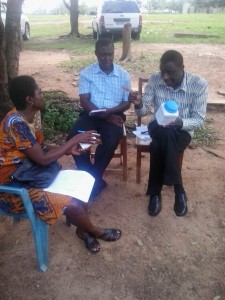Train, build trust before treating: Lessons from Ghana’s 2014 schistosomiasis MDA
February 27th, 2015
Getting a school-aged child to take medicine is no easy task, even if he knows it will keep him from getting sick. Now, imagine trying to get millions of children to do the same thing and you may begin to understand the challenge that Ghana’s Neglected Tropical Diseases Program (NTDP) faces every time the country has to administer medicine to prevent snail fever, also known as bilharzia or schistosomiasis (SCH).
Nevertheless, the NTDP was quite successful in reaching vulnerable populations—mainly school-aged children—across the country with medicine for SCH in 2014. The results from Ghana’s late 2014 mass drug administration (MDA) for SCH are still coming in, but with an average coverage rate of almost 85% in the 39 districts that have submitted their data so far, the country looks to be on track to exceed the World Health Organization’s (WHO) minimum treatment goal of at least 75% of at-risk school-age children.
The secret to the NTDP’s success is doing lots of training, followed by outreach to teachers, parents and the community, and the use of schools for treatment delivery. The training covered topics such as managing drug distribution, handling adverse side effects, and conducting outreach activities.
Outreach is important in several regards. First, to reach key stakeholders—especially the school children themselves, their parents, and community opinion leaders—with key messages, such as ensuring that children eat before they take the drugs and drink lots of water afterward, and reporting adverse reactions quickly to the nearest health facility. Second, outreach is needed to invite the families of children that do not attend school to come to the local school for their children’s treatment.

School children in Ghana apprehensively await their turn to take medicine that will help them stay healthy. Photo: FHI360
One month before the 2014 MDA, the NTDP held a national workshop to train the trainers, which brought together deputy directors of public health, regional disease control officers and regional NTD coordinators, as well as regional School Health Education Programme (SHEP) coordinators from the Ghana Education Service (GES). After the NTDP adapted the training curriculum (with support from FHI360 staff), regional and district-level trainings were held for district directors of health, district SHEP coordinators, district disease control officers, head teachers, school health education coordinators and circuit supervisors of the GES.
Community outreach began shortly before the treatment started. The NTDP decided to use multiple communication channels to ensure that the messages would reach everyone and be clearly understood. Among these were announcements at meetings of Parents and Teachers Associations (PTA), church and mosque groups, and other community groups as well as on community radio. In addition, the NTDP fitted mobile vans with public address systems and sent them to broadcast information to the community. In addition, the NTDP asked schools to send home parent notification and Information sheets with students before administering the drugs to obtain parental consent.
As the time approached to begin administering the medicine (praziquantel) in November, 2014, the NTDP formed monitoring teams at the national, regional and district levels. The monitoring teams visited all the regions during the distribution period and their reports indicated that other than a few hiccups during the MDAs, the drug administration went well. Regional and district-level teams successfully handled the few reported cases of mild to moderate adverse reactions, which included symptoms such as dizziness, drowsiness, weakness, headache or stomachache, and which very rarely required admission for observation in health facilities. In every case, those admitted were discharged after a few hours of observation.

A national monitoring team meets during the November 2014 MDA for schistosomiasis in Ghana. Photo: FHI360
It’s important to also mention that during the 2014 MDA, there was one report of a schoolgirl in the Assin South district in the Central region who died several days after taking the SCH medicine. An NTDP team led by Deputy Program Manager Dr. Ben Marfoh and Dr. Sally Ann Ohene, a representative of the WHO, immediately visited the region to investigate the report, meeting with school authorities, family members of the child, and health personnel in the district and region. However, an autopsy revealed that the girl had already been sick when she took the praziquantel, and that she had died of another cause. After conducting additional social mobilization and outreach to allay the fears of children and parents, the NTDP continued treatment in that region.
In addition to continuing to analyze the data from the November 2014, the next step for Ghana’s NTDP is to conduct an integrated survey for SCH and soil-transmitted helminthiasis (STH) in the country’s 216 districts. According to WHO guidelines, the survey should be conducted 6 months after the final round of 5 rounds of MDA (the 2014 MDA for SCH was Ghana’s fifth round of treatment[1]); as such, it is planned for May or June 2015.
In 2015, the NTDP plans to conduct MDA only in the 47 districts where at least 50% of the population has the disease, since only those districts require annual treatments according to WHO guidelines. However, the NTDP plans to hold a meeting in the latter half of 2015, to review the 2015 survey results and make any necessary revisions to the current SCH and STH treatment regimens in its 216 districts. Any necessary revisions in treatment frequency will begin in 2016.[2]
[1] The NTDP was unable to conduct MDA for SCH in 2013 due to the unavailability of praziquantel that year.
[2] According to WHO guidelines for treating SCH, annual treatment with praziquantel is recommended in districts with prevalence equal to or greater than 50%; treatment once every 2 years is appropriate for districts with prevalence equal to or greater than 10% but less than 50%; and treatment once every 3 years is sufficient for districts with prevalence greater than 1% but less than 10%. School age children (SAC) are treated in any of these districts, while special high-risk adults (mainly in fishing communities) are treated only in districts requiring annual treatments.


